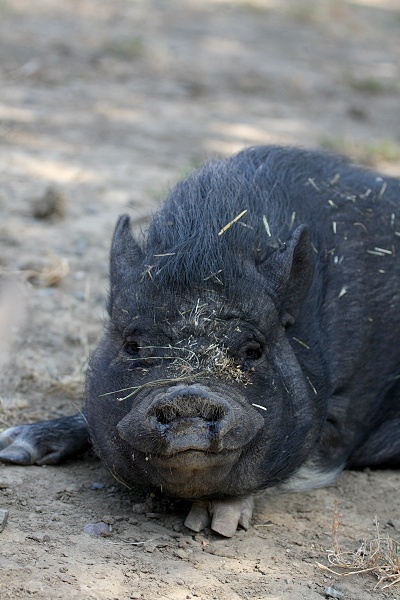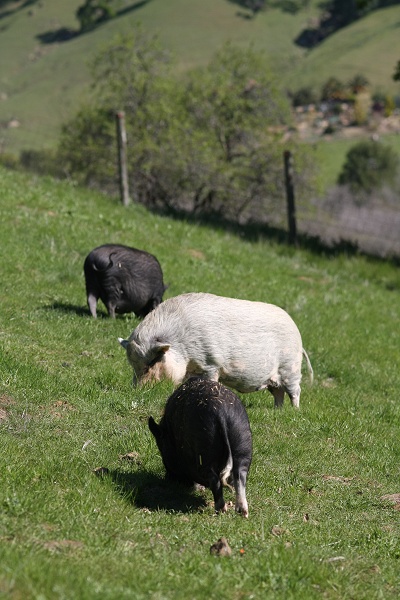Almost all American potbellied pigs can trace their ancestry to these two parent lines.
Potbellied pigs are small, by farming standards. Sometimes called "miniature pigs", their weights range from 80-200 lbs. Morbidly obese potbellied pigs may weigh more. Pigs raised for their meat often top out at 800 lbs and can exceed 1,000 lbs (though that is less common, healthy adult "farm" pigs weigh between 500-800lbs). Unlike modern production pigs who can reach full size in a year, potbellied pigs do not reach their full size for 3-5 years, misleading people into believing they will remain small.
While potbellied pigs are intelligent, clean animals, their upsurge in popularity spelled disaster for the pigs themselves. Shelters soon had to deal with an influx of unwanted potbellied pigs. Cities and counties either created laws to permit the animals or forced pig guardians to give up their pigs. Finding a veterinarian was (and still is) difficult - dog and cat vets were unused to the special needs of porcines. And people who thought potbellied pigs required nothing more than food and water soon learned they required a lot more than that - pigs are rooters and can easily damage a backyard and garden with their sturdy noses. It turns out potbellied pigs make for good companions in very limited circumstances.
 As if the potbellied pig craze wasn't bad enough, enter the teacup pig. A creepy term no doubt riding on the coat-tails of the "teacup" "insert dog breed name" craze.
As if the potbellied pig craze wasn't bad enough, enter the teacup pig. A creepy term no doubt riding on the coat-tails of the "teacup" "insert dog breed name" craze.Started in the UK on a farm that is more interested in parading around a menagerie of baby animals than doing anything useful for all animals, the Pennywell Miniature Pig (PMP) is a hodge-podge of different pig breeds. The small pigs' creators are not very clear on what breeds comprise the tiny porcine. And it is all the more strange, because finding a picture of an adult Pennywell Miniature Pig is like finding a needle in the proverbial haystack.
Physically, they are different in some ways to potbellied pigs - they have shorter snouts, more upturned noses, a straighter back and their drooping bellies are less pronounced than in your standard potbellied pig. Their coloration is more in line with breeds like the Kune Kune, a rare New Zealand breed of pig who can reach sizes up to 400 lbs (primarily intact boars).
If you know even a little about genetics, you know that cross-breeding different sizes and types of animals can lead to interesting results. For example, when you cross a Labrador Retriever with a Poodle to produce the faddish Labradoodle, you end up with puppies with a curly coat (Poodle) and puppies with a straight coat (Labs) - that is, you do not end up with a consistent physical "type" of puppy (unlike if you crossed two purebred Labs).
The same can be said of the Pennywell Miniature Pig. Since there appear to be so few adults in existence, or at least on public display, there is no guarantee that the pig, when he reaches full size at 3-5 years, will be the size of a Spaniel (50-60 lbs) or the size of a Kune Kune (100-400lbs).
 Even more telling is this statement: "After several false pregnancies the miniature pig gave birth to her brood at Pennywell Farm."
Even more telling is this statement: "After several false pregnancies the miniature pig gave birth to her brood at Pennywell Farm."Not being able to reproduce normally is not a good sign. It indicates there may be underlying genetic problems exacerbated by inbreeding, intense line-breeding or just a lack of concern about their breeding program (as it applies to animal health).
Now, there is no doubt these are cute pigs. Who doesn't find a piglet in a coffee mug adorable? But the sad truth is that this is a fad. Fads are never in the best interest of the animals. They flood the market with the desired good, in this case an actual living, animal, without any care for the consequences. Right now, the fad is limited to people who can afford to pay $800-$1,500 for these animals. But unscrupulous breeders, seeing how "cool" and trendy these engaging animals are, will no doubt seize the opportunity to make some money.
Pigs are not easy to place. There are not a low of homes available to them, no matter their size. We certainly hope teacup piglets do not become mainstream, that folks interested in welcoming a pig into their lives do the necessary research and always, always, always adopt. They are intelligent, fun, wonderful companion animals, but their special care, longevity and medical needs often exceed the expectations of even the greatest of homes. You can learn more about the care requirements for pot bellied pigs at the California Pot Bellied Pig Association.







4 comments:
good write!
Our sanctuary has taken in 9 potbelly pigs rescued from a hoarder situation. Don't know what would have happened to them without sanctuaries having opening. That being said, we know first hand that pigs that need re-homing have a hard time getting a home.
What a shame, every person who buys or adopts a pbp, should be made to read this, and alot of other materials. Information and education is the key to solving this problem. These animals are tremendous, intelligent and great pets, but only dedicated owners need apply.
People need eduaction and training. These animals are intelligent, strong willed and deserve stable homes and owners. I would love to have a sanctuary...I have two pbp's now, and they are my heart!
Post a Comment